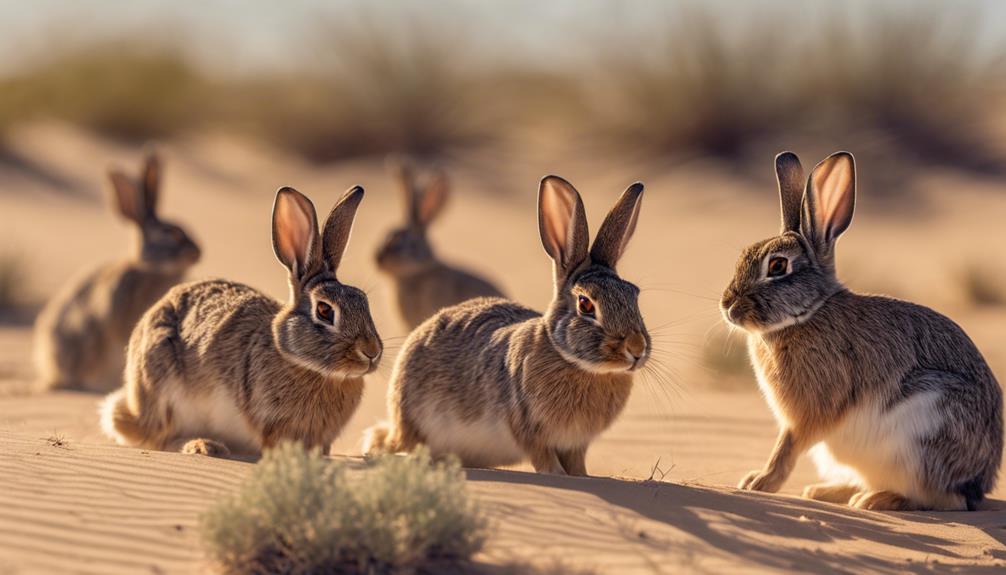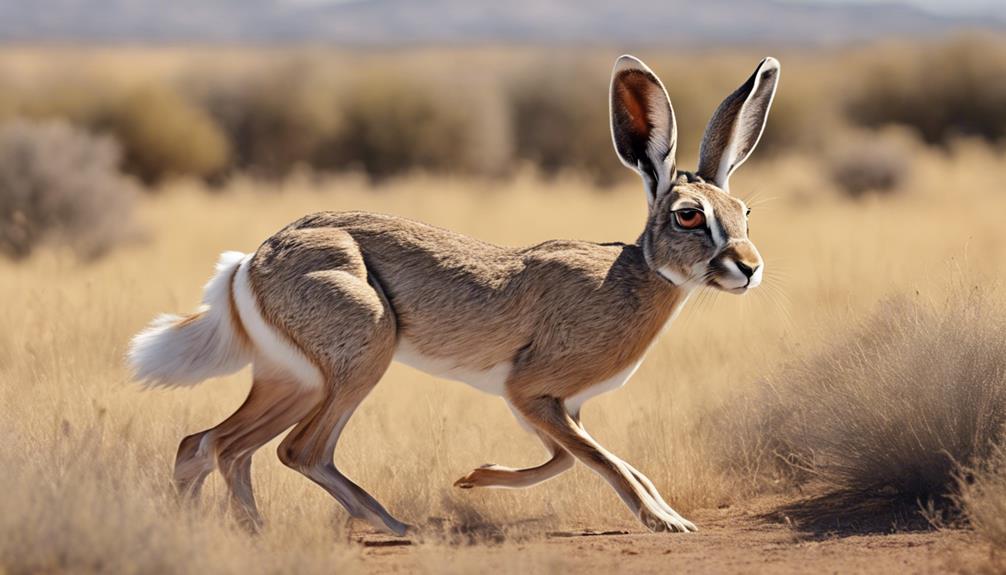Exploring 10 Wild Rabbit Species and Their Habitats
Embark on a journey to discover 10 wild rabbit species in their unique habitats. Arctic Hares thrive in snowy tundras with keen senses and robust legs. Coastal Brush Rabbits blend in with dark fur, using intricate burrow systems near the coast. Marsh Rabbits excel in wetlands with agile evasion tactics and herbivorous diets. Pygmy Rabbits create elaborate burrows in sagebrush territories. Snowshoe Hares adapt with changing fur colors in conifer forests. European Rabbits navigate grasslands with intricate warrens. From desert-dwelling Cottontails to swift Antelope Jackrabbits, each species showcases fascinating adaptations. Discover more about these intriguing creatures!
Arctic Hares in Tundra Regions
When exploring the vast tundra regions, one can't help but be captivated by the elusive Arctic Hares darting across the snowy landscape. These remarkable creatures have evolved a set of adaptations that allow them to thrive in the harsh Arctic conditions. Arctic hares boast a dense fur coat that provides insulation against the biting cold, while their large, powerful hind legs enable them to traverse the snowy terrain with remarkable agility. Their keen sense of smell and exceptional hearing aid in detecting predators such as Arctic foxes and birds of prey, allowing them to swiftly evade danger.
In the frigid tundra ecosystems where Arctic hares reside, the climate is unforgiving, with long, cold winters and short, cool summers. Despite these challenging conditions, tundras host a surprising variety of plant and animal life, showcasing a unique biodiversity. The vegetation in tundra regions is characterized by low-growing plants like mosses, lichens, and shrubs that have adapted to survive in the cold climate. This vegetation, in turn, supports a range of herbivores like lemmings and voles, which form a crucial part of the Arctic hare's diet.
Arctic hares exhibit fascinating behaviors in response to their environment. They're primarily crepuscular, meaning they're most active during dawn and dusk when the tundra landscape is bathed in soft light. This behavior helps them avoid predators while maximizing their foraging opportunities. Their social structure is relatively solitary, with individuals coming together mainly during the breeding season. Overall, the Arctic hares' adaptations, behavior, and interactions within the tundra ecosystem exemplify the remarkable resilience of wildlife in extreme environments.
Brush Rabbits in Coastal Areas
Nestled along the coastal regions, Brush Rabbits thrive in diverse habitats characterized by dense vegetation and proximity to the ocean. These rabbits have evolved specific coastal adaptations to survive in such environments. Their fur is often darker and more coarse compared to other rabbit species, providing better camouflage among the shadows of the coastal shrubbery.
Brush Rabbits exhibit interesting burrow behavior, often creating intricate tunnel systems within the dense undergrowth. These burrows serve as both shelter from predators and protection against the coastal winds that can be harsh at times. The rabbits are known to be crepuscular, meaning they're most active during dawn and dusk, utilizing the low light conditions to forage for food while minimizing the risk of being spotted by predators.
Their diet consists of a variety of plants and grasses found in the coastal areas, providing them with the necessary nutrients to thrive in this unique ecosystem. Being prey animals, Brush Rabbits have developed keen senses of hearing and smell to detect danger quickly, allowing them to dart back into the safety of their burrows at the slightest hint of a threat.
Marsh Rabbits in Wetlands
Among the intricate ecosystems of wetlands, Marsh Rabbits exhibit fascinating adaptations to thrive in their watery habitats. These rabbits have evolved specific behaviors and characteristics that enable them to navigate the challenges of living in marshy environments. Here are some key aspects of Marsh Rabbits' lives in wetlands:
- Burrow Behavior: Marsh Rabbits are known for their adept digging skills, creating intricate burrow systems along the edges of wetlands. These burrows provide shelter from predators and harsh weather conditions, allowing them to remain hidden and safe when needed.
- Predator Evasion: To evade predators like snakes, birds of prey, and even alligators that are common in wetlands, Marsh Rabbits rely on their keen senses and agility. They're quick to dart into the safety of their burrows or leap into the water to escape imminent danger.
- Foraging Habits and Breeding Season: Marsh Rabbits are herbivores that feed on a variety of aquatic plants, grasses, and sedges found in wetlands. During the breeding season, which typically occurs in the spring and summer months, these rabbits become more active in foraging to support their energy needs and reproductive efforts.
Pygmy Rabbits in Sagebrush
In the arid expanses of sagebrush, Pygmy Rabbits demonstrate remarkable adaptations to survive in their dry and shrubby habitats. These tiny rabbits are masters of burrow architecture, utilizing their keen digging skills to create intricate underground tunnels that provide shelter from the harsh elements and predators alike. The Pygmy Rabbit's burrows aren't just simple holes in the ground; they often consist of multiple entrances and interconnected chambers, allowing for quick escapes and efficient predator evasion.
When it comes to their dietary preferences, Pygmy Rabbits primarily feed on sagebrush, which is abundant in their natural habitat. Despite the tough and fibrous nature of sagebrush, these rabbits have specialized digestive systems that enable them to extract the nutrients they need to thrive. This selective feeding behavior helps them maintain a balanced diet while minimizing competition with other herbivores in the area.
In terms of social behavior, Pygmy Rabbits are generally solitary creatures, preferring to lead independent lives within their territories. However, during the breeding season, they may form temporary bonds with mates to raise their young. These brief periods of social interaction are crucial for the continuation of the species, ensuring the survival of the next generation of Pygmy Rabbits in the sagebrush ecosystem.
Snowshoe Hares in Conifer Forests
Emerging from the sagebrush terrain, Snowshoe Hares navigate the dense conifer forests with agility and stealth, blending seamlessly into their surroundings as they adapt to the intricacies of their wooded habitat. These remarkable creatures exhibit fascinating behavior that aids in their survival within the coniferous ecosystem.
- Camouflage Mastery: Snowshoe Hares possess fur that changes color with the seasons, allowing them to match the snow-covered winter landscape or the greenery of summer. This remarkable adaptation helps them evade predators such as lynxes and owls, enhancing their chances of survival in the forest.
- Nighttime Activity: Snowshoe Hares are primarily crepuscular, meaning they're most active during dawn and dusk. This behavior not only helps them avoid diurnal predators but also enables them to capitalize on the periods when their main predators are less active.
- Dynamics of Predator-Prey Interactions: In conifer forests, Snowshoe Hares engage in intricate predator-prey dynamics with animals like lynxes and coyotes. Their ability to swiftly navigate the dense vegetation and use their camouflage effectively influences the outcomes of these interactions, showcasing the delicate balance of nature in the forest ecosystem.
Observing Snowshoe Hares in conifer forests provides a glimpse into the intricate world of predator-prey relationships and the remarkable adaptations these hares have developed to thrive in their environment.
European Rabbits in Grasslands
Navigating the expansive grasslands, European Rabbits display a remarkable ability to adapt and thrive in their open habitat. These rabbits are known for their intricate burrowing behavior, creating vast interconnected warrens beneath the earth that provide shelter from predators and harsh weather conditions. Their grazing habits are meticulous, carefully selecting a variety of grasses, herbs, and other vegetation to maintain a balanced diet.
The reproduction cycle of European Rabbits is a fascinating process to observe. These prolific breeders can produce several litters a year, with each litter consisting of multiple offspring. The young rabbits, known as kittens, are born hairless and blind, relying heavily on their mother's care and protection in the safety of the burrow.
Despite their adaptability and resilience, European Rabbits face various predators and threats in their grassland habitats. Natural predators such as foxes, birds of prey, and snakes pose a constant danger to these rabbits. Additionally, habitat loss due to agriculture and urbanization, as well as diseases like myxomatosis, have significantly impacted European Rabbit populations in certain regions.
Desert Cottontails in Arid Deserts

Amidst the harsh, arid deserts, Desert Cottontails exhibit remarkable resilience and resourcefulness in adapting to their challenging environment. These small mammals have developed unique survival strategies that enable them to thrive in the arid landscapes they call home.
- Survival Strategies: Desert Cottontails have evolved several clever tactics to survive in the unforgiving desert environment. They're primarily nocturnal, avoiding the scorching heat of the day by staying in their burrows and emerging under the cover of darkness to forage for food. Their keen senses help them detect predators quickly, allowing them to escape danger effectively.
- Burrow Construction: One of the key adaptations of Desert Cottontails is their skillful burrow construction. These rabbits dig intricate burrow systems in the sandy soil, providing them with shelter from the extreme temperatures and predators. Their burrows also serve as safe havens for raising their young, offering protection and insulation from the harsh desert conditions.
- Camouflage and Foraging: Desert Cottontails have developed a sandy-colored fur coat that acts as a natural camouflage, blending seamlessly with the desert surroundings and offering them protection from predators. Their diet consists of a variety of desert plants, roots, and grasses, which they forage for during the cooler nights when moisture levels are slightly higher, ensuring they stay hydrated in the arid environment.
Mountain Cottontails in Rocky Habitats
In rocky habitats, Mountain Cottontails display remarkable agility and adaptability, showcasing their ability to thrive in challenging terrains. These cottontails are known for their impressive ability to navigate the rugged landscapes with ease, utilizing their strong hind legs to hop between rocks and crevices swiftly. Their behaviors in rocky terrains are fascinating to observe; they often exhibit cautious movements, carefully scanning their surroundings for any signs of danger before darting off into cover.
Rocky terrain adaptations are essential for Mountain Cottontails' survival. Their fur, which is typically a blend of gray and brown tones, provides excellent camouflage against the rocky backdrop, allowing them to blend in seamlessly with their environment and evade potential predators. These rabbits have also developed strong muscles in their hind legs, enabling them to make quick escapes and navigate the uneven terrain effectively.
When it comes to foraging for food in rocky habitats, Mountain Cottontails display resourcefulness by seeking out vegetation and small plants that grow in crevices or rocky outcrops. Their keen sense of smell helps them locate hidden food sources, while their cautious nature ensures they remain vigilant against any lurking threats.
Antelope Jackrabbits in Open Plains

Across the vast expanse of open plains, Antelope Jackrabbits exhibit remarkable speed and agility in their pursuit of survival. These sleek creatures have adapted to thrive in the challenging environment of the open plains, showcasing specific behaviors that aid in their survival.
- Jackrabbit Behavior: Antelope Jackrabbits are known for their exceptional running abilities, reaching speeds of up to 40 miles per hour to evade predators such as coyotes and hawks. Their long legs and powerful hind muscles enable them to make quick getaways across the flat terrain, demonstrating their keen sense of survival instincts.
- Camouflaging Techniques: In the open plains ecosystem, biodiversity is abundant, and Antelope Jackrabbits have evolved to blend in with their surroundings to avoid detection. Their sandy fur coat provides effective camouflage against the golden grasslands, allowing them to remain inconspicuous and out of harm's way.
- Adaptation to Harsh Conditions: The open plains can be unforgiving, with extreme temperatures and scarce food sources posing constant challenges. Antelope Jackrabbits have adapted by being crepuscular, meaning they're most active during dawn and dusk when temperatures are milder, conserving energy during the harsh midday sun and maximizing their chances of survival.
In the vast openness of the plains, Antelope Jackrabbits navigate a delicate balance between predator and prey, showcasing their remarkable resilience and agility in the face of adversity.
Swamp Rabbits in Marshy Environments
Navigating the murky waters of marshy environments, Swamp Rabbits display unique adaptations to thrive in this challenging habitat. These rabbits have distinct habitat preferences, favoring wetlands, swamps, and marshes where they can find ample sources of food and cover. Their diet choices reflect their surroundings, consisting of aquatic plants, grasses, and sedges that are abundant in these watery habitats.
Despite the abundance of food, Swamp Rabbits face predation risks from various predators such as foxes, bobcats, and birds of prey. To counter these threats, they've developed survival strategies like excellent swimming abilities. When sensing danger, Swamp Rabbits will quickly take to the water, where they can swim away from predators with surprising speed. Additionally, their cryptic coloration helps them blend into the marshy vegetation, providing them with effective camouflage against potential threats.
Swamp Rabbits' adaptation to marshy environments showcases their remarkable ability to thrive in challenging habitats. By honing their habitat preferences to wetlands, adjusting their diet choices, and developing survival strategies to evade predation risks, these rabbits have carved out a niche for themselves in the murky and dynamic world of marshes.
Frequently Asked Questions
How Do Wild Rabbits Adapt to Extreme Weather Conditions?
In extreme weather conditions, wild rabbits adapt by constructing well-insulated burrows to maintain a stable temperature.
They change fur color for seasonal camouflage, blending into surroundings for protection.
Their foraging strategies become more efficient, ensuring a stable food supply.
What Predators Pose a Threat to Wild Rabbit Species?
Predators like foxes, hawks, and snakes pose a serious threat to wild rabbit species. Predator-prey dynamics play a crucial role in the survival of rabbits, as they must constantly be on alert for hunting behavior from these predators.
Foxes are skilled hunters that can swiftly catch rabbits, while hawks use their sharp talons to swoop down and snatch them up. Snakes, with their stealthy approach, also contribute to the challenges wild rabbits face in evading predators.
Do Wild Rabbits Hibernate During Harsh Winters?
During harsh winters, wild rabbits don't hibernate. Instead, they rely on their natural survival strategies to endure the cold. These small mammals exhibit unique winter behavior, such as burrowing into the ground or seeking shelter in dense vegetation to stay warm.
Their ability to adapt to the ecological challenges of winter showcases the resilience of wild rabbit species in the face of changing environmental conditions.
How Do Rabbits Communicate Within Their Social Groups?
When wild rabbits communicate within their social groups, they rely on a variety of methods. Vocal cues, body language, scent marking, and thumping behavior all play important roles in their interactions.
Through subtle movements, sounds, and scents, rabbits convey information about their mood, intentions, and social hierarchy. Observing these cues can provide valuable insights into the intricate dynamics of rabbit communities.
What Is the Average Lifespan of Different Wild Rabbit Species?
Rabbits, in the wild, have varying lifespans depending on the species. Their survival strategies and reproductive cycles greatly influence this.
By adapting foraging behaviors and predator avoidance techniques, rabbits increase their chances of living longer. Each wild rabbit species has evolved to navigate its specific habitat, impacting its average lifespan.
Understanding these factors sheds light on the diverse ways different rabbit species have developed to thrive in their environments.
Conclusion
You've just scratched the surface of the diverse world of wild rabbits and their unique habitats.
From the snowy tundras to the dry deserts, each species has adapted to thrive in their specific environment.
By understanding and appreciating these incredible creatures and the ecosystems they call home, we can work towards preserving their habitats and ensuring their continued survival in the wild.
Keep exploring and learning about these fascinating rabbit species and their habitats!
